Jacobins Worksheets
Do you want to save dozens of hours in time? Get your evenings and weekends back? Be able to teach about the Jacobins to your students?
Our worksheet bundle includes a fact file and printable worksheets and student activities. Perfect for both the classroom and homeschooling!
Resource Examples
Click any of the example images below to view a larger version.
Fact File
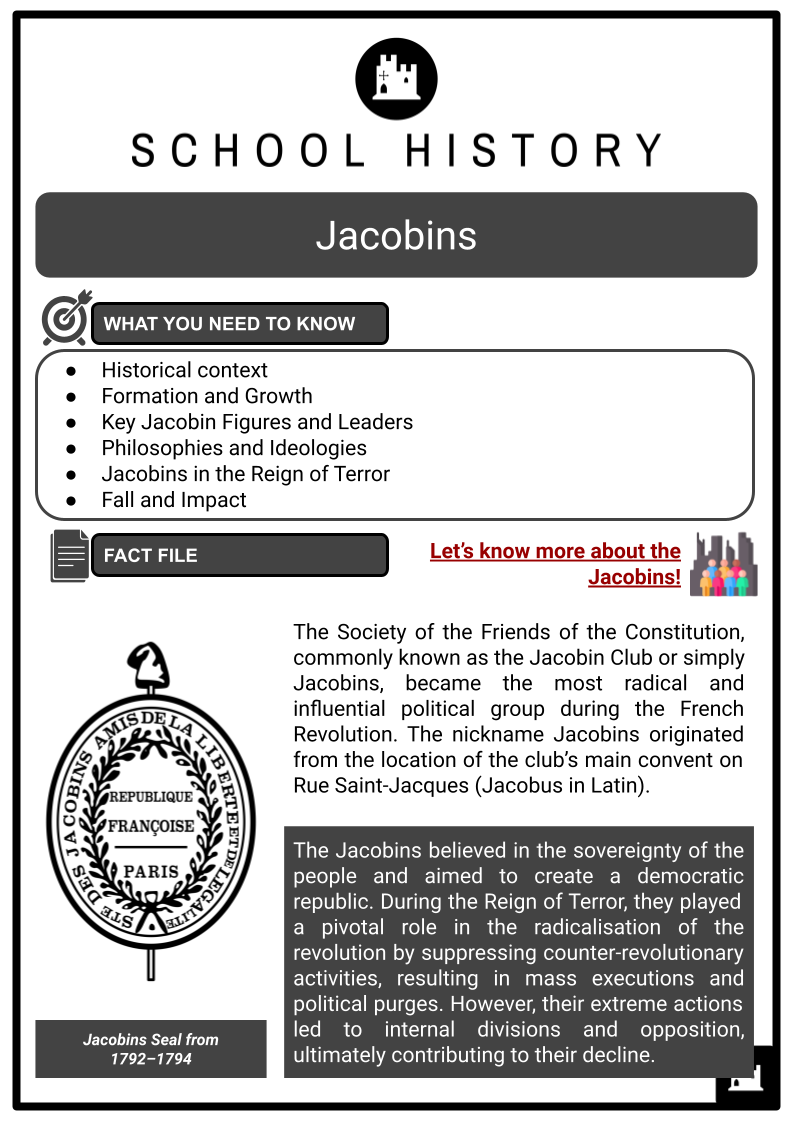
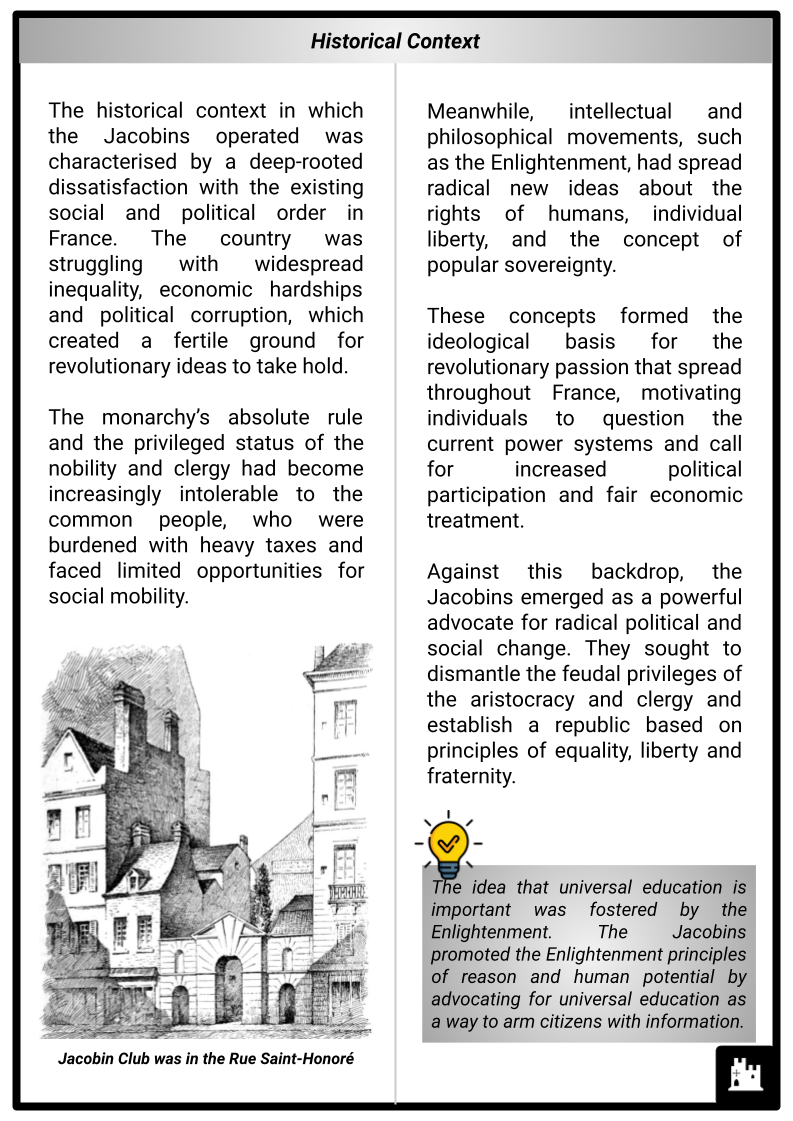
Student Activities
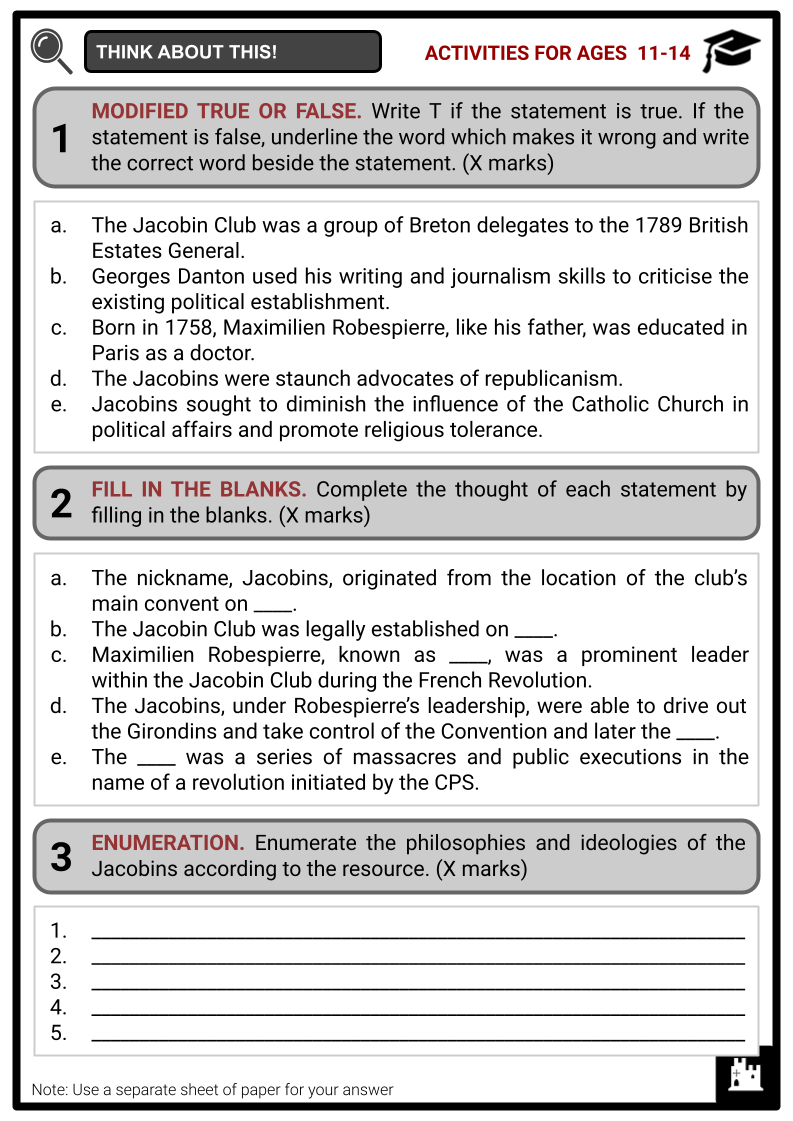
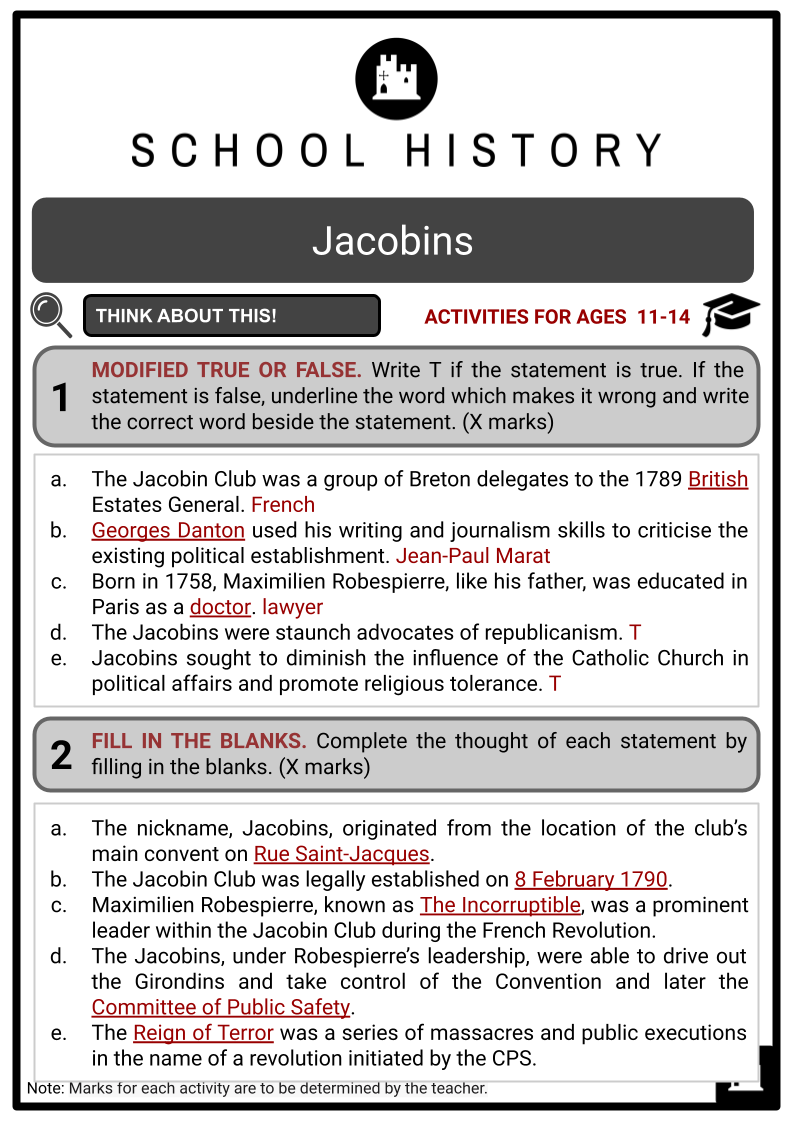
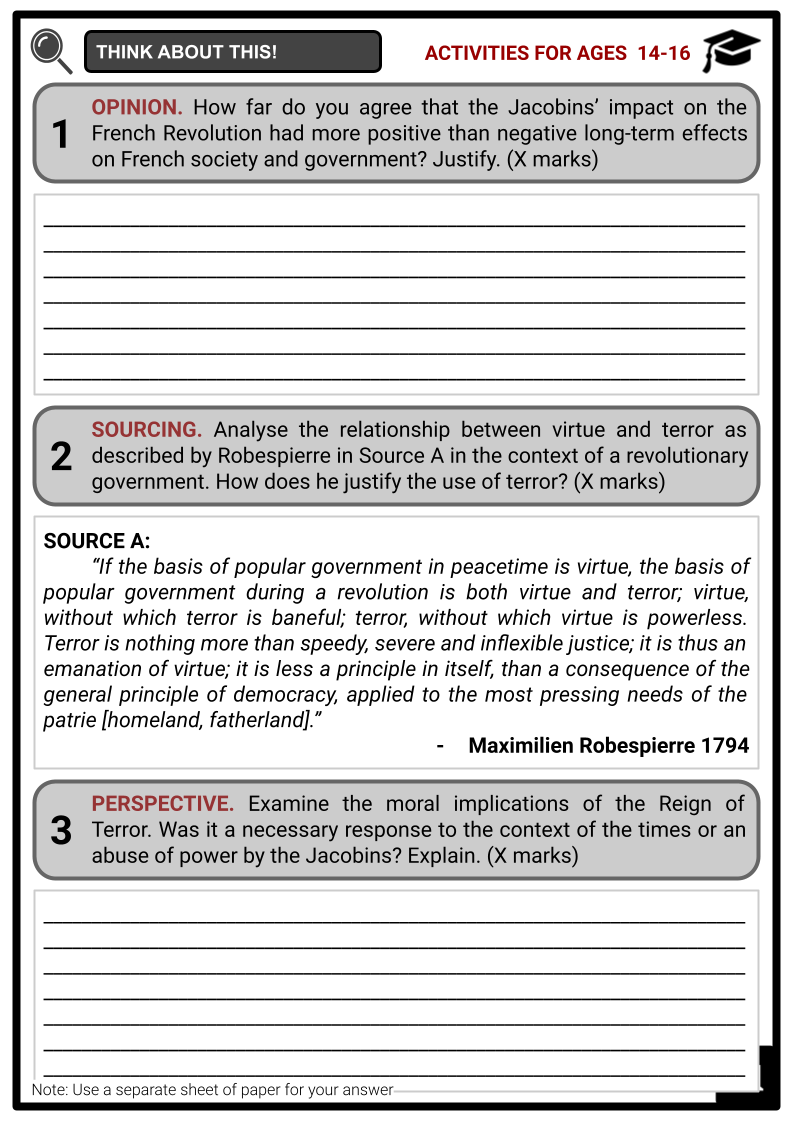
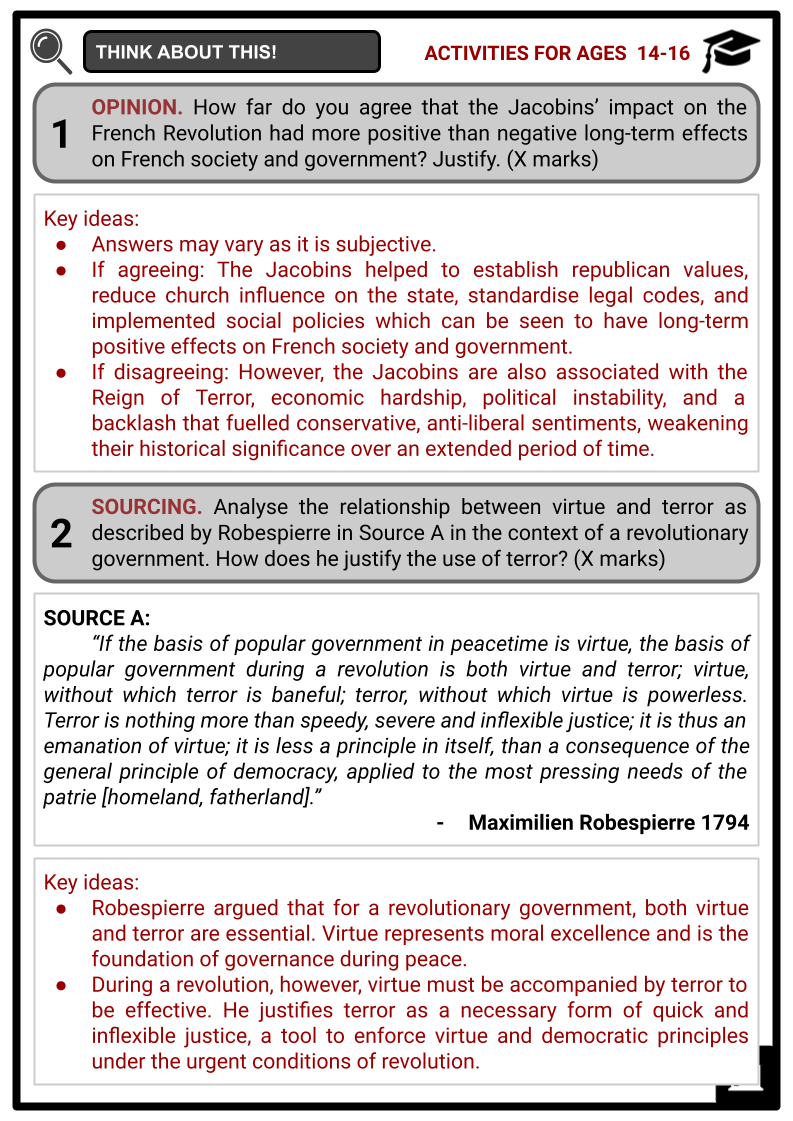
Summary
- Historical context
- Formation and Growth
- Key Jacobin Figures and Leaders
- Philosophies and Ideologies
- Jacobins in the Reign of Terror
- Fall and Impact
Key Facts And Information
Let’s know more about the Jacobins!
The Society of the Friends of the Constitution, commonly known as the Jacobin Club or simply Jacobins, became the most radical and influential political group during the French Revolution. The nickname Jacobins originated from the location of the club’s main convent on Rue Saint-Jacques (Jacobus in Latin).
The Jacobins believed in the sovereignty of the people and aimed to create a democratic republic. During the Reign of Terror, they played a pivotal role in the radicalisation of the revolution by suppressing counter-revolutionary activities, resulting in mass executions and political purges. However, their extreme actions led to internal divisions and opposition, ultimately contributing to their decline.
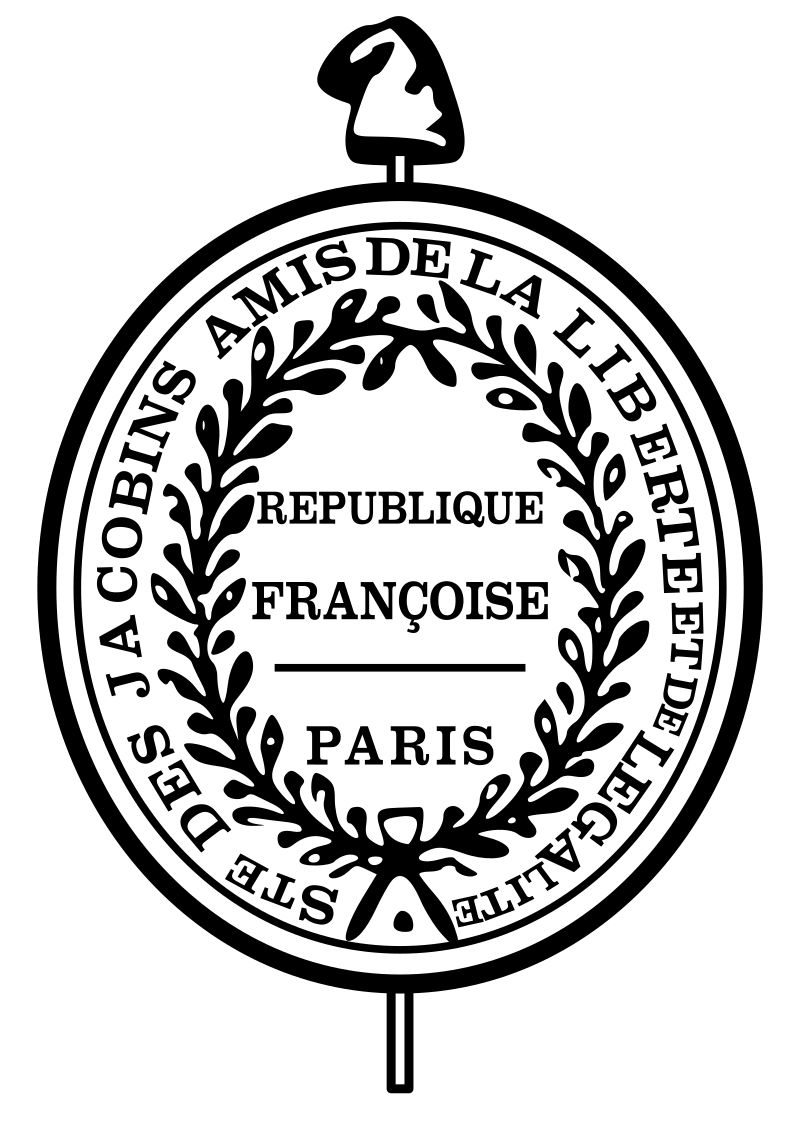
Historical Context
- The historical context in which the Jacobins operated was characterised by a deep-rooted dissatisfaction with the existing social and political order in France. The country was struggling with widespread inequality, economic hardships and political corruption, which created a fertile ground for revolutionary ideas to take hold.
- The monarchy’s absolute rule and the privileged status of the nobility and clergy had become increasingly intolerable to the common people, who were burdened with heavy taxes and faced limited opportunities for social mobility.
- Meanwhile, intellectual and philosophical movements, such as the Enlightenment, had spread radical new ideas about the rights of humans, individual liberty, and the concept of popular sovereignty.
- These concepts formed the ideological basis for the revolutionary passion that spread throughout France, motivating individuals to question the current power systems and call for increased political participation and fair economic treatment.
- Against this backdrop, the Jacobins emerged as a powerful advocate for radical political and social change. They sought to dismantle the feudal privileges of the aristocracy and clergy and establish a republic based on principles of equality, liberty and fraternity.
The idea that universal education is important was fostered by the Enlightenment. The Jacobins promoted the Enlightenment principles of reason and human potential by advocating for universal education as a way to arm citizens with information.
Formation and Growth
- The Jacobin Club was a group of Breton delegates to the 1789 French Estates General. Later, motivated by a letter from the Revolution Society of London to the Assembly congratulating the French on recovering their independence, it was refounded as the Société de la Révolution in November 1789. After relocating to Paris, the club welcomed more citizens, including foreigners, as members.
- Meetings of the Jacobin Club evolved into forums for radical speech advocating for various changes such as separation of church and state, republicanism, universal suffrage, and extensive education. It was legally established on 8 February 1790.
- The goals of the Jacobin Club were:
- To discuss issues that would be determined by the National Assembly beforehand.
- To work towards the establishment and fortification of the constitution in line with the spirit of the preamble.
- To communicate with other similar societies.
- The club’s constitution was decided upon, and the election procedure rules were established. Committees were to be elected to oversee the club’s administration, correspondence, presentations, elections and four secretaries, in addition to a treasurer. Any member who demonstrated that their beliefs ran counter to the rights of individuals and the constitution would be banished.
- By the end of 1790, the Jacobins had established a network of branches throughout France. Clubs like the Jacobins, the Club des Cordeliers, and the Cercle Social were taking centre stage in French politics by the beginning of 1791.
- Up to the very last moment of the republic’s founding (20 September 1792), the Jacobin Club favoured the monarchy. They released their own petition demanding the replacement of King Louis XVI in place of supporting the 17 July 1791 petition for the king’s overthrow.
- Different factions within the Jacobin Club emerged as a result of internal conflicts that the organisation experienced as it rose to prominence and influence in French politics.
The Indulgents were another faction within the Jacobins that advocated for moderation and leniency, opposing the excesses of the Reign of Terror, which put them at odds with the more radical Montagnards.
- The Girondins and Montagnards were both revolutionary groups in France with shared Enlightenment ideals and an anti-monarchical stance. They, however, had key differences.
- The Girondins were moderates who favoured a federalist government, gradual change, and were less inclined to extreme economic or violent measures. They were also divided on the execution of King Louis XVI.
- The Montagnards, on the other hand, were radicals who supported a centralised government, economic reforms for the poor, and were proponents of the Reign of Terror, including the execution of the king.
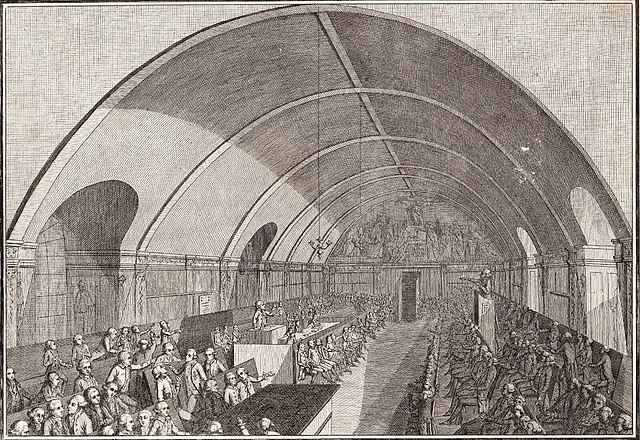
Key Jacobin Figures and Leaders
- The Jacobins were guided by a prominent set of individuals who had significant involvement in moulding the club’s beliefs and its impact during the French Revolution.
- Some of the key figures and leaders of the Jacobins include: Maximilien Robespierre, Georges Danton, Jean-Paul Marat and Jean-Paul Rabaut Saint-Étienne.
- Maximilien Robespierre, known as ‘The Incorruptible’, was a prominent leader within the Jacobin Club during the French Revolution. He was known for his commitment to equality, liberty and fraternity, championing radical ideas like the abolition of the monarchy, the republic, and social and economic justice.
- As the Revolution progressed, Robespierre’s influence extended beyond the Jacobin Club to the broader political landscape of France, leading to the formation of the Committee of Public Safety. Under his leadership, the Committee implemented radical measures to safeguard the ideals of the Revolution. However, his uncompromising stance and pursuit of revolutionary goals led to controversy and conflict, including the Reign of Terror.
- Georges Danton, a charismatic orator within the Jacobin Club, was a key figure in shaping the club’s revolutionary vision. His fiery speeches and persuasive rhetoric fuelled support for the radical cause, advocating for direct action and popular violence. His leadership, including organising the insurrection of 10 August 1792, demonstrated his commitment to revolutionary change.
Figures associated with the Jacobin Club were also contributors to the Encyclopédie. This encyclopedic project was grounded in the Enlightenment’s principles of reason, evidence-based knowledge and critical thinking, marking a significant shift towards intellectual progress and secularism.
- Jean-Paul Marat advocated for radical political and social change during the French Revolution. As a former physician and scientist, Marat used his writing and journalism skills to criticise the existing political establishment. His publication, ‘L’Ami du peuple’, incited the masses against the monarchy, aristocracy and clergy.
- Jean-Paul Rabaut Saint-Étienne was a passionate advocate for Republican principles. He used his eloquence to rally support for the Jacobin cause and advocate for a republic based on equality and liberty. His leadership promoted key reforms, such as the separation of church and state, universal suffrage, and extensive educational opportunities.
Philosophies and Ideologies
- The Jacobins were fuelled by Enlightenment principles, advocating for republican democracy and the creation of a society grounded in liberty and equality. Their political agenda was transformative, seeking to restructure both government and societal norms based on these progressive ideologies.
- Some of the key philosophies and ideologies of the Jacobins include: republicanism and popular sovereignty, social equality and justice, secularism and separation of church and state, radical democracy and universal suffrage, and revolutionary justice and state control.
Republicanism and Popular Sovereignty
- The Jacobins were staunch advocates of republicanism, which emphasised the idea of a state without a monarch and with power vested in the people. They believed in the principle of popular sovereignty, asserting that the ultimate authority resided in the hands of the citizens rather than a hereditary ruler. This philosophy formed the cornerstone of their vision for a new political order in France.
Social Equality and Justice
- Central to the Jacobin ideology was the belief in social equality and justice. They sought to dismantle the existing feudal privileges of the aristocracy and clergy, advocating for equal rights and opportunities for all citizens. They aimed to create a society where individuals were not held back by their social status or birthright but rather judged on their merit and contribution to the nation.
Secularism and Separation of Church and State
- The Jacobins supported secularism and church–state separation. They wanted to reduce Catholic political influence and promote religious tolerance. This supported their ideal of a society where people might practise their faith without state or religious intrusion.
Radical Democracy and Universal Suffrage
- Jacobin democracy promoted universal suffrage and citizen participation. They thought that everyone should have political power and that the people should drive government choices.
Revolutionary Justice and State Control
- The Jacobins promoted revolutionary justice, which led to Maximilien Robespierre’s Reign of Terror. State control and brutal repression of counter revolutionary activity typified this period. The Jacobins believed such drastic measures were necessary to protect the revolution and destroy state opponents.
Jacobins in the Reign of Terror
- The Jacobins and their leaders, most notably Maximilien Robespierre, were significant during the French Revolution, particularly the Reign of Terror that lasted from September 1793 to July 1794.
- Born in 1758, Maximilien Robespierre, like his father, was educated in Paris as a lawyer. In 1789, he was elected a deputy of the Estates-General as well as in the National Constituent Assembly. By April 1790, Robespierre had consolidated power after being elected president of the Jacobin Club.
- After the fall of the monarchy in August 1792, he became the first deputy to the National Convention. It was the same convention that abolished the monarchy, declared the French republic, and had King Louis XVI tried and executed.
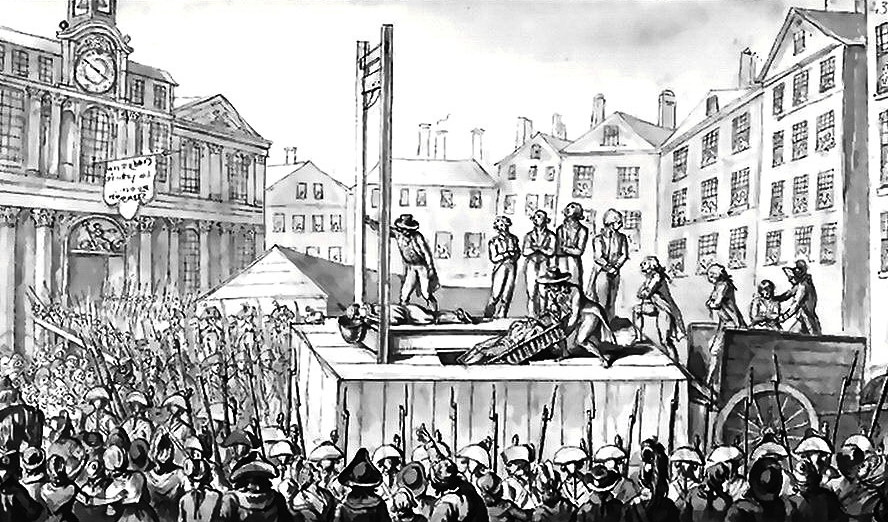
- Power struggles between the Jacobins and Girondins escalated after the king’s execution. The Jacobins, under Robespierre’s leadership, were able to drive out the Girondins and take control of the Convention and later the Committee of Public Safety (CPS).
- As an influential member of the CPS, Robespierre orchestrated the Reign of Terror, which eliminated counter- revolutionaries. He also started the cult of the Supreme Being, a brand-new official religion, in France. For 11 months, about 300,000 alleged enemies were arrested, while an estimated 17,000 were executed, predominantly by guillotine.
- When the Jacobins, led by Robespierre, took dominant control of the National Convention and the CPS in June 1793, administrative and political purges were called. The Jacobins, supported by the sans-culottes, saw violence as a way of insisting on their political goals and ideologies. The Reign of Terror was a series of massacres and public executions in the name of a revolution initiated by the CPS.
- Reasons for the Reign of Terror:
- As the Jacobins dominated the Convention, they feared counter-revolutionaries, especially the Girondins, whom they labelled as royalist sympathisers, would overturn the cause of the Revolution.
- The passage of the Law of Suspects legalised political terror and targeted royalists for treason.
- In addition to the Girondins, the Jacobins were alarmed by the threat posed by foreign armies, especially on the French frontiers.
Fall and Impact
- As the Reign of Terror continued, public opinion turned against the Jacobins, leading to a backlash and mounting opposition to their methods. The turning point came with the arrest and execution of Robespierre and his associates in July 1794. Their demise ushered in a period of political realignment and the emergence of more moderate leadership in the form of the Thermidorian Reaction.
- Anti-Jacobin publications started to criticise the Jacobins because they denied endorsing Robespierre and backed an unpopular return to the Terror.
- The society's membership dropped, and its finances collapsed. 93% of the clubs closed in less than a year after the National Convention enacted a decree permanently closing the clubs.
- The lasting impact of the Jacobins is felt in the broader context of the French Revolution and its aftermath. Their radical vision for societal transformation influenced future political movements and struggles for reform.
- However, their extreme measures and state control raised questions about the balance between revolutionary fervour and individual rights preservation.
Image Sources
- https://upload.wikimedia.org/wikipedia/commons/thumb/c/c6/Seal_of_Jacobins_of_Paris_%28Republican%29.svg/800px-Seal_of_Jacobins_of_Paris_%28Republican%29.svg.png
- https://upload.wikimedia.org/wikipedia/commons/thumb/f/fd/Soci%C3%A9t%C3%A9_des_amis_de_la_Constitution_-_Vangorp%2C_del._Masquelier%2C_sculp.jpg/640px-Soci%C3%A9t%C3%A9_des_amis_de_la_Constitution_-_Vangorp%2C_del._Masquelier%2C_sculp.jpg
- https://upload.wikimedia.org/wikipedia/commons/2/2f/Octobre_1793%2C_supplice_de_9_%C3%A9migr%C3%A9s.jpg
Frequently Asked Questions
- Who were the Jacobins?
The Jacobins were members of a radical political club during the French Revolution. They were named after the former convent of Saint Jacob in Paris, where they initially met.
- What were the beliefs and goals of the Jacobins?
The Jacobins advocated for republican democracy, social equality, and secularism. They aimed to abolish the monarchy, establish a republic, and promote the rights of the common people.
- Who were some prominent figures associated with the Jacobins?
Prominent Jacobin leaders included Maximilien Robespierre, Georges Danton, and Jean-Paul Marat, among others.
